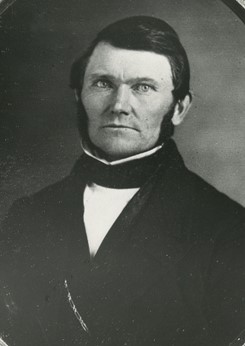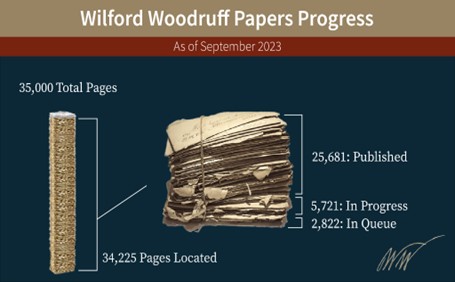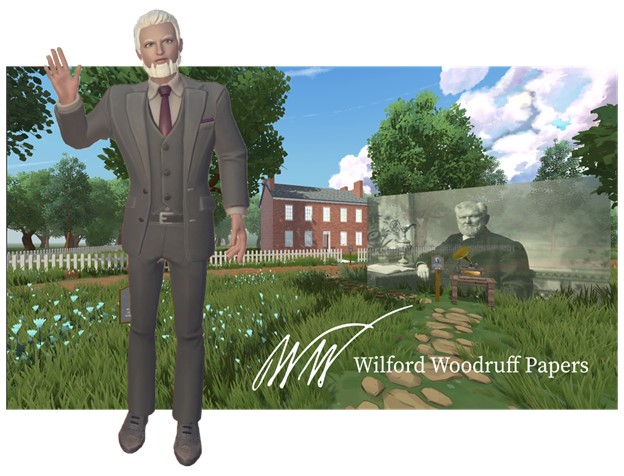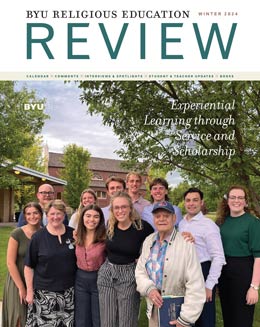Bringing Wilford Woodruff to Life
Steven C. Harper
Steven C. Harper (steven_harper@byu.edu) is a professor of Church history and doctrine at Brigham Young University.
Shortly after his baptism into The Church of Jesus Christ of Latter-day Saints in 1833, Wilford Woodruff began keeping a journal. He wrote that his intent was to give an account of his stewardship because it is “not only our privilege but duty to keep an accurate account of our proceedings.”[1] He believed deeply, as he wrote, “This will make a valuable legacy to our children and a great benefit to future generations by giving them a true history of the rise and progress of the Church and the Kingdom of God upon the earth in this last dispensation.”[2]
 Wilford Woodruff, 1849. Courtesy of The Church of Jesus Christ of Latter-day Saints.
Wilford Woodruff, 1849. Courtesy of The Church of Jesus Christ of Latter-day Saints.
President Woodruff did his part by keeping the records. But if those records remain in attics and archives, they won’t fulfill their purpose of blessing future generations with a true history of the Savior’s latter-day work.
Jennifer Ann Mackley has spent much of her life solving that problem. Mackley is a lawyer by training, but by passionate avocation she is a student of Wilford Woodruff’s records, especially of what they say about the Lord’s restoration of temple ordinances and covenants. She began researching Wilford’s writings in 1996 and published Wilford Woodruff's Witness: The Development of Temple Doctrine.
The Wilford Woodruff Papers Foundation
In 2020 Mackley cofounded the Wilford Woodruff Papers Foundation with Donald W. Parry, professor of Hebrew Bible and Dead Sea Scrolls at Brigham Young University. The Wilford Woodruff Papers Foundation is an independent, nonprofit organization. It is not officially sponsored by The Church of Jesus Christ of Latter-day Saints, but it could not have accomplished all it has without the close cooperation and constant support of the Church History Department. The Church History Library (CHL) staff provides the Wilford Woodruff Papers Project access to President Woodruff’s documents in the CHL’s possession, along with technical know-how, research assistance, and experience. Additionally, several of the people who work on the Wilford Woodruff Papers gained expertise from their prior work on the Joseph Smith Papers. Moreover, Joseph Smith Papers scholars Matthew C. Godfrey, Andrew H. Hedges, R. Eric Smith, and Jordan T. Watkins serve as advisers to the Wilford Woodruff Papers editorial team.
The Joseph Smith Papers encompass the written record of Church history from 1828 to 1844 and include the founding documents of the Restoration of the gospel of Jesus Christ. The Wilford Woodruff Papers are a much larger collection covering the period from 1834 to 1898. They add immensely to the story of the Restoration. With so much misinformation easily accessible online, it is vital to make these primary, eyewitness sources of restored knowledge accessible to truth seekers. Therefore, the mission of The Wilford Woodruff Papers is, by 2027, to publish at wilfordwoodruffpapers.org Wilford’s eyewitness account of the Restoration of the gospel of Jesus Christ.
We are publishing images of President Woodruff’s documents online along with accurate transcriptions that are easy to read and to search. Our purpose is to inspire all people, especially the rising generation, to study and increase their faith in Jesus Christ, understand and honor sacred temple covenants, and thereby receive the blessings of exaltation with their families.

The People behind the Project
Beside the foundation’s executive director, Jennifer Mackley, a host of talented, hardworking, and devoted disciples of Jesus Christ do the work of the Wilford Woodruff Papers Project. Only a few representatives can be mentioned here. Krystyna Hales has degrees in anthropology and crisis and emergency management. She is the operations and human resources manager—the heart and brain of the workforce. Jon Fackrell is the senior software engineer. An innovative and highly recruited professional with degrees in engineering and library science, Jon built wilfordwoodruffpapers.org, including a robust, behind-the-scenes content management system and interface with the text editing program at fromthepage.com. LaJean Purcell Carruth has been translating Wilford Woodruff’s shorthand since the 1970s. She is a senior historian at the Church History Library and an adviser to the Wilford Woodruff Papers Project. She provides knowledge and skill no one else has, giving people access to Wilford’s records as no one else can.
The Wilford Woodruff Papers Foundation is governed by a unique board of directors that includes descendants of Wilford Woodruff, accomplished professionals and educators, church and community leaders, and entrepreneurs. Every board member is more than one of those at the same time. Board chair Jordan Woodruff Clements is Wilford’s great-great-grandson, a former mission president and YSA stake president, and a corporate leader with extensive experience serving and leading nonprofit organizations. The board members and their impressive cadre of advisers are all committed donors themselves. For example, adviser Steven C. Wheelwright is an ambassador for the foundation.[4] He is the Harvard University Edsel Bryant Ford Professor of Management Emeritus, at Harvard University. He was president of BYU–Hawaii after many years as a professor and administrator. His devotion to the Wilford Woodruff Papers and his desire to share them with everyone grew from reading Jennifer Mackley’s book, Wilford Woodruff's Witness: The Development of Temple Doctrine, while presiding over the Boston Massachusetts Temple with his wife, Margaret Steele Wheelwright. Margaret not only donates to the project. She works as an editorial assistant along with her daughter, Kristy Taylor, who serves on the board of directors.
Paying for the Wilford Woodruff Papers Project
Documentary editing of this quality is a painstaking and laborious process. It begins with accurate transcription of handwritten documents by a trained paleographer—a handwriting expert. Then teams of editorial assistants read and verify every word on every page to ensure accuracy. In addition, talented and devoted researchers identify each person and place mentioned in the documents. Then they link the names of people mentioned in the Papers to biographies and link places mentioned to interactive maps. These reference materials enable users to better search and understand the documents.
Papers projects are expensive. They consume a great amount of human and material resources, but they don’t generally generate wealth. Their value is best measured in the knowledge they make available, not in money—so they almost always present the problem of funding. A creative combination of resources is solving that problem for the Wilford Woodruff Papers Foundation. One component is unlikely human resources. Most of the work of the Wilford Woodruff Papers is done by paid student interns and volunteers. Associate editor Ashlyn Pells and general editor Jason Godfrey are both recent college graduates who began working on the project while they were still in school. Along with research specialist McKenzie Wood and others, these young scholars have long since shouldered responsibilities that are done by experienced MAs or PhDs at other projects. They have proven equal to every assignment, and they are typical of dozens of college-aged (and a few even younger) students who learn fast and who compose an efficient and capable workforce. Several former editorial assistants are now on missions, where their service is inspired by their intimate knowledge of Wilford’s, one of the greatest missionaries of the last dispensation.
The other part of the solution for funding the project is donors who value the knowledge in the Wilford Woodruff Papers more than the money it costs to publish those papers. The edifying insights found in Woodruff’s documents are also one of the best work benefits for the editorial assistants who find them while they are immersed in the writing of Woodruff and his contemporaries. Recently one such editorial assistant, Joseph Flake, described transcribing letters from prospective missionaries to President Woodruff, in which they responded to the Lord’s call to serve. Flake said,
I was struck by the sacrifices these missionaries were asked to make to obey their calls. When I left on my mission at eighteen years old, I had no career, no commitments, and no one to support. Yet these brethren write of leaving behind spouses, children, and jobs. In those days, disease was much more threatening than it is today, and these elders often had no idea if they would come home safe, if their loved ones would be alive if they did return, how well their families would be provided for in their absence, and if the livelihoods they spent years investing in would be there for them when they got back. Whenever I feel it is hard to sacrifice what the Lord asks of me, I try to remember those who have sacrificed much, much more than me. I know these elders were blessed for their faithfulness in serving the Lord, and so will all of us when we choose to follow our Heavenly Father’s plan for us, even when it is hard.

Editorial assistants like Joseph Flake collaborate and share, but the project is virtual, meaning all work is done on personal computers, and funds are not spent on physical office space or equipment. Even so, it costs several million dollars to identify, transcribe, verify, research, and publish at wilfordwoodruffpapers.org the tens of thousands of pages Wilford Woodruff wrote. The Wilford Woodruff Papers Project is funded by donations from faithful, generous individuals, families, and charitable organizations, all of their own free will.
These donors are anxiously engaged in the good cause of financing the project. Led by Sarah Dunn, The Carol Smith Fund contributed $100,000 earmarked to provide Inspired Learning Experience scholarships to BYU students who work for ten to twenty hours a week on the Woodruff Papers. Administered by Religious Education at BYU, all of these funds go directly to students. Donations like the Smith Fund’s not only enable the day-to-day work; they also cover the creation and maintenance of the content management system, including the website, to store and display the documents. Donors have access to annual reports of expenditures and metrics showing the Wilford Woodruff Papers Project’s progress and success. The foundation has a four-star profile on Charity Navigator and is a Gold Level GuideStar participant, demonstrating its commitment to transparency in every aspect of its operations. Visit wilfordwoodruffpapers.org to learn how you can contribute time, money, or documents to the project.
Wilford Woodruff Links the Past, Present, and Future
The Wilford Woodruff Papers Project is committed to innovatively connecting the past with the present and the future. Wilford Woodruff was the first prophet of the last dispensation to have his voice recorded and preserved for posterity, using the Edison phonograph, the most advanced technology of his age. Using the marvels of artificial intelligence, the Wilford Woodruff Papers Foundation, in collaboration with LIVINGHISTORY.ai, has pioneered the Wilford Woodruff AI Learning Experience.[3] Now people can ask President Woodruff questions and hear answers—his answers, in his own words—as captured in the tens of thousands of pages of his experience, teaching, and testifying.
Asking AI Wilford Woodruff what actual Wilford Woodruff learned from Joseph Smith about actual intelligence will amaze you. “I have been playing with the AI experience for an hour now and can’t get enough,” one user reported. When was the last time you heard someone describe listening to and learning from a prophet as playing? “Wilford has answered every question eloquently and I have learned so much.” “How amazing,” another user said. “I can listen to the testimony of a prophet who lived 150 years ago.” And another: “I have felt the Spirit multiple times and am amazed at how much he knows and how accurate he is.”
President Woodruff did his part by keeping the records. The Wilford Woodruff Papers Project is bringing the records from attics and archives to you in an open-access internet site. But Wilford Woodruff’s records won’t bless future generations with the truths of the Savior’s latter-day work if they are not accessed. It’s up to you to solve that problem. Join the visitor to wilfordwoodruffpapers.org who said, “I’m excited to see where it’s headed and to share it with more people.” In short, there’s nothing artificial about the intelligence you’ll receive from Wilford Woodruff here.
Notes
[1] Wilford Woodruff’s Journal, p. 8, The Wilford Woodruff Papers Project, wilfordwoodruffpapers.org/
[2] Wilford Woodruff’s Journal, February 12, 1862, p. 196, The Wilford Woodruff Papers, wilfordwoodruffpapers.org/
[3] “Decoding a Prophet with Artificial Intelligence,” May 25, 2022, The Wilford Woodruff Papers, wilfordwoodruffpapers.org/
[4] Developing Wilford Woodruff as a Leader: An Interview with Steven Wheelwright. https://
